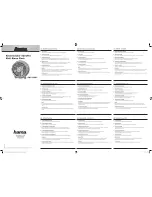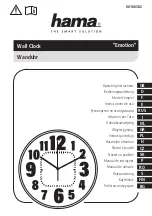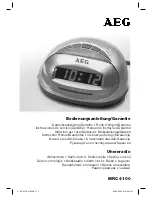
5
4)
The clock will return to the main menu, to exit the main menu, press the
←
key.
To
enter or modify the alarm
, you should:
1)
Call the configuration menu by pressing the
MENU
key.
2)
Select the
„F6”
function using the
↑
and
↓
keys and confirm it with the
→
key.
3)
Using the
↑
and
↓
keys, select one of the available alarms
(from A1 to A30)
and confirm it with the
→
key.
A 1
alarm 1
…
A 30
alarm 30
4)
Using the
↑
and
↓
keys, activate an alarm (
On Y)
and confirm it with the
→
key.
5)
Using the
↑
and
↓
keys, modify the time of activating the alarm. Successively enter: first the hour, next the minute, and
confirm the parameters with the
→
key.
6)
Using the
↑
and
↓
keys, enter the alarm duration period in seconds
(t)
and confirm it with the
→
key.
7)
Using the
↑
and
↓
keys, select your preferred alarm mode:
ALLd
(ever day)
SELd
(selected days) and confirm it with the
→
key.
8)
If you choose the
SELd
mode (selected days), you should subsequently select the days in which the alarm is to be active (e.g.
active on Monday
d1 Y
, inactive on Monday
d1 n
), every time proceeding by using the
→
key.
d1
Monday
d2
Tuesday
…
d7
Sunday
To
activate the ECO mode of the display,
you should:
1)
Call the configuration menu by pressing the
MENU
key.
2)
Select the
„F7”
function using the
↑
and
↓
keys and confirm it with the
→
key.
3)
Using the
↑
and
↓
keys, activate the ECO mode „
ECO Y
”
and confirm it with the
→
key.
ECO Y
yes
ECO n
no
4)
Using the
↑
and
↓
keys, modify the value of the entered time of
activating the clock display
, next confirm it with the
→
key.
5)
Using the
↑
and
↓
keys, modify the value of the entered time of
deactivating the clock display
, next confirm it with the
→
key.
6)
The clock will return to the main menu, to exit the main menu, press the
←
key.
NOTE!
When the ECO mode is active (
ECO Y
) and the time of activating and deactivating the clock is the same, the clock will
be
on
for 24 hours.
To
change the display font shape,
you should:
1)
Call the configuration menu by pressing the
MENU
key.
2)
Select the
„F8”
function using the
↑
and
↓
keys and confirm it with the
→
key.
3)
Using the
↑
and
↓
keys, select your preferred font shape and confirm it with the
→
key.
Fnt1
rounded font
Fnt2
seven-segment font
To
restore factory settings of the clock by using the remote control,
you should:
1)
Call the configuration menu by pressing the
MENU
key.
2)
Select the
„F9”
function using the
↑
and
↓
keys and confirm it with the
→
key.
3)
Using the
↑
and
↓
keys, select
res Y
and confirm it with the
→
key.
NOTE!
This function is used to fully restore factory settings, including resetting the alarm and making the default network
configuration. This function doesn't reset a remote control codes. When the device is equipped with LAN module the
network settings will be reset as well.
To
set a unit of measurement for the displayed temperature and its offset
using a remote control, you should:
1)
Call the configuration menu pressing the
MENU
key.
2)
Select the
F10
function using the keys
↑
and
↓
and confirm it with the key
→
.
3)
Using the
↑
and
↓
keys, select a unit of measurement for the temperature and confirm it with the
→
key.
tU °C
Cesius degrees
tU °F
Fahrenheit degrees
4)
Using the keys
↑
and
↓
select „
Of Y”
and confirm it with the key
→
.
Summary of Contents for ZA series
Page 7: ...7 ...






























